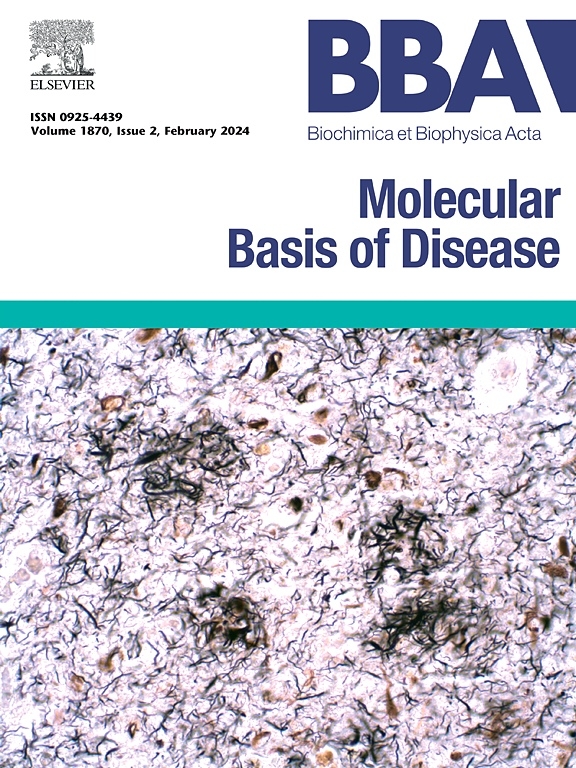Colchicine inhibits monosodium urate crystal-mediated inflammation by influencing F-actin formation
IF 4.2
2区 生物学
Q2 BIOCHEMISTRY & MOLECULAR BIOLOGY
Biochimica et biophysica acta. Molecular basis of disease
Pub Date : 2024-12-01
DOI:10.1016/j.bbadis.2024.167602
引用次数: 0
Abstract
Objectives
To understand the mechanism by which colchicine inhibits the inflammatory properties of monosodium urate (MSU) crystal deposits and tophi.
Methods
We investigated the effects of colchicine on the inflammatory properties of monosodium urate (MSU) crystal deposits in several models: (i) In vitro tophus formation by MSU and neutrophils; (ii) MSU-induced peritonitis model; (iii) Alpha-1-antitrypsin-induced peritoneal MSU flare model; (iv) MSU-induced arthritis model. We measured neutrophil numbers, NET formation, IL-1β production and F-actin generation by MSU crystals. In addition, we tested the effect of actin inhibitors SMIFH2, Cytochalasin B and Latrunculin B in the models.
Results
Colchicine did not affect neutrophil numbers in all these models. However, colchicine was highly effective to inhibit NET formation, IL-1β production and F-actin generation indicating less pronounced tophus formation, lower inflammatory properties of tophi and reduced conversion from G-actin into F-actin, respectively. F-actin was shown to accumulate in tophi without presence of colchicine and being resistant to degradation by DNase I. Actin inhibitors SMIFH2 and Cytochalasin B significantly reduced IL-1β and neutrophil elastase levels and mitigated MSU-induced arthritis.
Conclusion
Colchicine effects on gout flares are not based on reducing neutrophil numbers but on changing the functional properties of tophi by reducing their DNase-resistant F-actin concentrations and thereby reducing the negative impact of NETs on IL-1β production and the pro-inflammatory state of tophi. Actin inhibitors may be interesting tools to convey anti-inflammatory properties and reduction of flares in gout patients.

秋水仙碱通过影响f -肌动蛋白的形成抑制尿酸钠晶体介导的炎症。
目的:了解秋水仙碱抑制尿酸钠(MSU)晶体沉积和痛风石炎症特性的机制。方法:我们研究了秋水仙碱对尿酸钠(MSU)晶体沉积炎症特性的影响:(i) MSU和中性粒细胞在体外形成水状体;(ii) msu致腹膜炎模型;(iii) α -1抗胰蛋白酶诱导腹膜MSU耀斑模型;(iv) msu诱导的关节炎模型。我们通过MSU晶体测量了中性粒细胞数量、NET形成、IL-1β的产生和f -肌动蛋白的产生。此外,我们还检测了肌动蛋白抑制剂SMIFH2、Cytochalasin B和Latrunculin B在模型中的作用。结果:秋水仙碱对小鼠中性粒细胞数量无明显影响。然而,秋水仙碱对NET的形成、IL-1β的产生和f -肌动蛋白的产生都有很高的抑制作用,这表明痛风石的形成不那么明显,痛风石的炎症特性较低,g -肌动蛋白向f -肌动蛋白的转化减少。研究表明,在没有秋水仙碱存在的情况下,f -肌动蛋白可以在痛风石中积累,并且可以抵抗dna酶i的降解。肌动蛋白抑制剂SMIFH2和Cytochalasin B显著降低IL-1β和中性粒细胞弹性酶水平,减轻msu诱导的关节炎。结论:秋水仙碱对痛风发作的作用不是基于减少中性粒细胞的数量,而是通过降低痛风石抗dna酶的f -肌动蛋白浓度,从而改变痛风石的功能特性,从而减少NETs对痛风石IL-1β生成和促炎状态的负面影响。肌动蛋白抑制剂可能是传递抗炎特性和减少痛风患者耀斑的有趣工具。
本文章由计算机程序翻译,如有差异,请以英文原文为准。
求助全文
约1分钟内获得全文
求助全文
来源期刊
CiteScore
12.30
自引率
0.00%
发文量
218
审稿时长
32 days
期刊介绍:
BBA Molecular Basis of Disease addresses the biochemistry and molecular genetics of disease processes and models of human disease. This journal covers aspects of aging, cancer, metabolic-, neurological-, and immunological-based disease. Manuscripts focused on using animal models to elucidate biochemical and mechanistic insight in each of these conditions, are particularly encouraged. Manuscripts should emphasize the underlying mechanisms of disease pathways and provide novel contributions to the understanding and/or treatment of these disorders. Highly descriptive and method development submissions may be declined without full review. The submission of uninvited reviews to BBA - Molecular Basis of Disease is strongly discouraged, and any such uninvited review should be accompanied by a coverletter outlining the compelling reasons why the review should be considered.

 求助内容:
求助内容: 应助结果提醒方式:
应助结果提醒方式:


